
How to Use Moving Averages for Trend Trading — Practical Guide & Rules
Moving averages (MAs) are among the simplest and most powerful tools for identifying trends, smoothing noise, and defining entries/exits. This guide covers which MAs to use, how to choose periods and timeframes, crossover systems, confirmation techniques, risk management, and ready-to-use recipes for Forex, stocks and crypto traders.
Quick summary — key takeaways
- Use Simple MA (SMA) to observe long-term direction and Exponential MA (EMA) for responsive signals.
- Common period setups: 20/50/200 for trend structure; 9/21 for shorter, nimble entries.
- Combine MAs with price action and higher-timeframe confirmation to reduce false signals.
- Always size risk per trade and prefer trades that align with the higher-timeframe trend.
What a moving average does (simple explanation)
A moving average smooths price by averaging recent data points. It reduces noise so you can see the underlying trend direction. There are two common types:
- Simple Moving Average (SMA) — arithmetic mean of prices over N periods. Smooth but laggy.
- Exponential Moving Average (EMA) — gives more weight to recent prices, so it reacts faster to changes.
Which MA should you pick? (rules of thumb)
Choice depends on your time frame and style:
- Scalpers / Intraday: 8–21 EMA for quick signals (1–15m charts).
- Swing traders: 20 MA and 50 MA on 1H/4H charts for better noise control.
- Position traders: 100 / 200 SMA to define long-term trend (daily/weekly).
Start with classic sets (9/21/50/200) and tune to the instrument’s volatility.
Three practical MA-based trend setups
1) Trend filter + pullback entry (recommended)
Use a higher-timeframe MA as trend filter (e.g., daily 200 SMA). On your trade timeframe (4H/1H) wait for price to pull back to a shorter MA (20 SMA/EMA) and show a rejection (pin bar, bullish engulfing). Enter in direction of the higher-timeframe trend. This reduces mean-reversion losses and increases probability.
2) Two-MA crossover (simple system)
Entry: when the fast MA (e.g., 9 EMA) crosses above the slow MA (e.g., 21 EMA) — buy. Exit: when it crosses back below. Use higher-timeframe trend alignment and volume/ATR filter to avoid whipsaws. Always combine crossovers with a stop based on recent volatility.
3) MA Ribbon / Multi-MA confluence
A cluster of aligned MAs (e.g., 8/13/21/34 EMA) forming a ribbon indicates strong trend momentum. Look for pullbacks to the ribbon’s upper or lower edge for entries; the tighter the ribbon, the stronger the trend often is.
Entry, stop and target rules
A repeatable plan is essential. Example rule-set:
- Entry: Price closes above fast MA and above a confirmation candle (e.g., bullish engulfing) on 1H chart.
- Stop Loss (SL): below recent swing low or a multiple of ATR(14) (e.g., 1.5×ATR).
- Take Profit (TP): fixed R:R 1:2 or structure-based (next resistance / Fibonacci extension).
- Position sizing: calculate LOT so that SL risk = chosen % of account.
Reduce false signals — confirmation checklist
Moving averages give many signals; filter them:
- Confirm with higher-timeframe trend (only take trades in the same direction).
- Check volume or tick activity — good confirmation for breakouts.
- Use ATR to avoid taking signals in extremely low volatility environments.
- Avoid trading across major news events unless you have a tested plan.
Multi-timeframe approach (MTF)
Use a two-frame check: higher timeframe (e.g., daily) defines the bias; lower timeframe (e.g., 1H) times entries. Example: Daily 200 SMA is up → only take buys on 1H when price pulls back to 20 EMA and shows bullish price action.
Examples & visual rules (how to practice)
Backtest visually on 50–100 charts: mark MA crosses, filter by market structure, record SL/TP and outcome. Use demo accounts to forward test the exact MA periods you intend to use. Track win rate, average R:R and expectancy.
Common pitfalls and how to avoid them
- Whipsaw losses: avoid small-period crossovers on choppy markets; prefer higher-timeframe alignment.
- Overfitting: don’t optimize MA periods excessively on historical data — keep rules robust and simple.
- Ignoring volatility: fixed pip stops without ATR consideration lead to premature exits.
Combining MAs with other tools
Best results come from combining MAs with non-redundant indicators: price action, support/resistance, Fibonacci levels, and volume. An MA tells you direction; price action tells you context.
Sample strategy (ready-to-test)
Strategy: 21 EMA (fast), 50 SMA (trend), ATR(14) for stops.
- Bias: 50 SMA slope positive and price above 50 SMA → bullish bias.
- Entry: 21 EMA crosses above short pullback and a confirmation candle closes above 21 EMA on 1H.
- SL: 1.5×ATR below entry.
- TP: 2× risk or next swing resistance; trail with 21 EMA after price moves 1×ATR in your favor.
Broker & execution tips
Use brokers with reliable execution and low spread on your chosen instrument. For intraday MA trading, lower spreads and low latency matter. Always confirm that your platform's MAs match your backtest (some platforms use different price sources — close vs typical).
SEO-friendly internal & external linking strategy
Link this article to related pages and a few trusted external references:
- Other Moving Average Strategies (internal)
- Using ATR for Stop Loss (internal)
- Investopedia — Moving Average (external)
Final checklist before you trade
- Confirm higher-timeframe trend (200 SMA or 50 SMA).
- Validate entry with price action and ATR-based stop.
- Size position so SL risk = chosen % of account.
- Backtest and forward-test on demo for at least 3 months before scaling live.
Want our MA templates & backtest sheet? Send a message and we’ll share editable templates and a tracker.
Get MA Templates (WhatsApp)